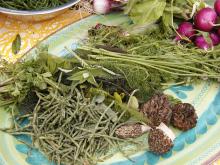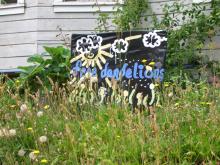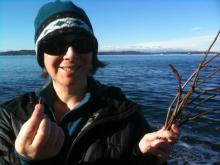By Melissa Poe
Anthropologists have written extensively about foraging traditions in small-scale societies, but few have examined wild food foraging practices in urban, post-industrial spaces. This can be explained, in part, to the predominant idea that “urban” and “nature” are mutually exclusive concepts. To address this gap, department alumnus Melissa Poe, with a team of geographers and policy analysts—including Marla Emery, Patrick Hurley, Rebecca McLain—has worked since 2008 to better understand urban foraging practices. Their ethnographic studies in Seattle, Philadelphia, and New York City have included several UW Anthropology graduate and undergraduate students, who have assisted with the Seattle project. To date, they have interviewed and collaborated with 75 individuals who collect over 400 plant and mushroom species in Seattle.
Despite the invisibility of urban foraging in academic writings, the team’s findings show that it is a vibrant practice in U.S. cities and suggest that subsistence-based resource practices persist in the urban spaces of advanced capitalism. These include activities such as picking fruits, berries, and mushrooms for food; harvesting edible “weedy” plants like dandelion, mustard, and plantain; digging edible roots and bulbs for food and medicine; and gathering fallen boughs and cones for craft material and use during holiday rituals.
While media stories list foraging among the top 10 “food trends” in recent years, it is not just a new vogue practice. The research team’s ethnographic data indicate that people have a long history of foraging in cities. In Seattle, for example, some have been active foragers for up to 60 years. People from all walks of life gather plants and fungi in the city: from “foodies,” to wildcrafters, to members of urban Native communities, to recent immigrants. The differences among foragers cut across age, gender, education, class, race, and ethnicity. People learn and pass on information about gathering from family members, professional botanists, amateur mycological society outings, field guides, and many other individuals. Their motivations for foraging are also quite diverse, and gathering may be more important for some groups than others. Foraging not only supports livelihoods by providing essential foods, medicine, and materials for urban households, but also creates opportunities for individuals and communities to maintain social ties and connect with nature. In this light, foraging is also a non-economic, non-utilitarian activity that can be a deeply relational practice; in the words of one forager, “everything we do is with a mindfulness of our connections to life—whether it be the life inside of us, the life inside of a plant, the life inside of an animal, another person.”
In addition to developing a basic understanding of who, what, where, how, and why people forage, the team’s work also examines key questions regarding how patterns of development and the distribution of urban nature might affect foraging access; how foragers navigate power relationships with land managers and owners; and how the management of green space impactsforagers. One example from the team’s research found that the renewed maintenance and harvest of neglected fruit trees in publically managed lands in Seattle is increasing food security for some urban residents. The team also found that city land-use policies prohibiting gathering plant material from public areas places foragers in precarious legal predicaments, even when foraged plant material is classified as “weedy” or invasive, such as edible stinging nettle, Japanese knotweed and Himalayan blackberry. Policies and management strategies like this need to be flexible and tailored to specific contexts. The research team hopes that their findings will help foster a dialogue with urban public land managers to address these broader environmental justice concerns.
This type of work on urban foraging helps to rethink ideas about urban forests and other green spaces as part of the larger food system where people find nourishment, maintain socio-cultural practices, and inhabit nature.
Funding/information
The Seattle Urban Gathering project is funded through a grant by the USDA Pacific Northwest Research Station, Green Cities Research Alliance, and the American Recovery and Restoration Act. Please see www.ifcae.org for more information or contact Dr. Melissa Poe at mpoe@ifcae.org.



